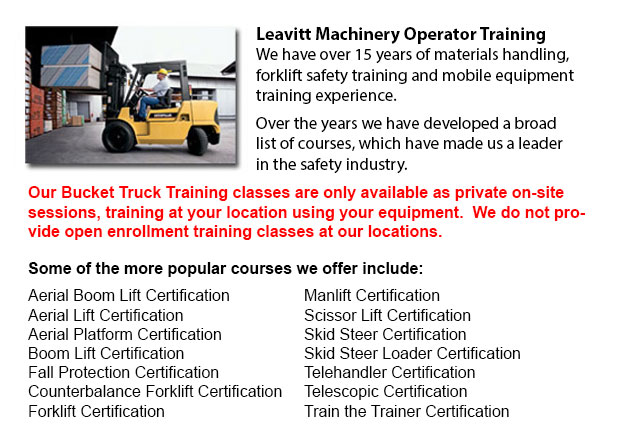
Surrey Bucket Truck Training - The Vehicle-Mounted Aerial Work Platform or likewise called bucket truck training program is intended to decrease the possibility of incident and personal injury when working in close proximity or with bucket trucks by efficiently training qualified operators. An aerial lift device is whichever vehicle-mounted device, articulating or telescoping, or both, that is used to position workers to reach locations that will otherwise be inaccessible. Aerial lift devices are used in order to elevate personnel to above-ground work locations.
The program aims to provide operators with the knowledge, skills, abilities, and training materials needed in order to efficiently and safely operate vehicle-mounted aerial work platforms.
The program has two parts: a hands-on session and a classroom training session. In order to become certified, participants should be successful in both parts. A wallet-size certificate and a full-size certificate would be issued upon completion of the program.
Types of lifts comprise articulating boom platforms, extensible boom platforms, vertical towers, aerial ladders and aerial ladder trucks and any combination of these devices. Aerial lift devices are usually constructed with wood, metal, fiberglass, reinforced plastic or other materials.
Definitions
Articulating boom platform: has two or more hinged boom sections.
Extensible boom platform: has either a telescopic boom or an extensible boom.
Platform: part of the aerial device that is designed to carry staff.
Mobile unit: any aerial device along with its components like vehicle and related equipment.
Employers have the responsibility to ensure their employee receive right training before operating aerial devices. Employees should make sure they also obtain the required training and that they do not operate lift devices if they are not authorized to do so. Employees should ensure that they have on the correct protective equipment while working from the platform.
Course content comprises operation of the vehicle-mounted aerial work platform, pre-shift inspection, safe operating practices, use of emergency controls, lifting capacity, and administering theory and practical tests. Operators will know rules under the local and federal regulations.
-
Surrey Zoom Boom Training
Surrey Zoom Boom Training - Zoom Boom Training focuses on properly training prospective operators on variable reach forklifts. The training goals include gaining the knowledge of the equipments physics and to be able to define the job of the operator... More -
Surrey Boom Lift Operator Training
Surrey Boom Lift Operator Training - The cherry picker work platform is a kind of work platform, which would typically include a bucket or platform at the hydraulic lifting system's end. The device is also called a boom lift, man lift, hydraladder or... More -
Surrey Forklift Training Program
Surrey Forklift Training Program - The lift truck is a common powered industrial vehicle which is in wide use these days. They are sometimes referred to as hi los, lift trucks or jitneys. A departments store will use the forklift to load and unload m... More -
Surrey Forklift Operator Certification
Surrey Forklift Operator Certification - Forklift operator certification is usually needed for employees working in industrial, warehouse or construction environments to guarantee the safe utilization of forklifts. Workplace training must follow a me... More -
Surrey Crane Operator Certification
Surrey Crane Operator Certification - The process to enable you to be able to operate particular kinds of cranes is to take crane operator certification training to acquire certification. The certification process consists of hands-on practice, class... More -
Surrey Heavy Equipment Ticket
Surrey Heavy Equipment Ticket - Depending on the nature of the task at hand, the kind of construction equipment which a heavy equipment operator utilizes differs. Every kind of equipment is built to carry out particular tasks in the most efficient ma... More -
Surrey Order Picker License
Surrey Order Picker License - Order preparation operation or also called order picking as it is more commonly known is a process utilized in warehouse operations and consists of staff called order pickers. The order picker's task is to take and colle... More -
Surrey Boom Lift Safety Training
Surrey Boom Lift Safey Training - Boom lifts are a type of elevated work platform or aerial lifting device which are normally utilized in industry, warehousing and construction. Boom lifts can be utilized in virtually whichever environment due to the... More

Forklift Certification Surrey
TOLL FREE: 1-888-254-6157
24389 Fraser Highway
Langley, British Columbia
forkliftcertificationsurrey.com
Email Us
About Us



